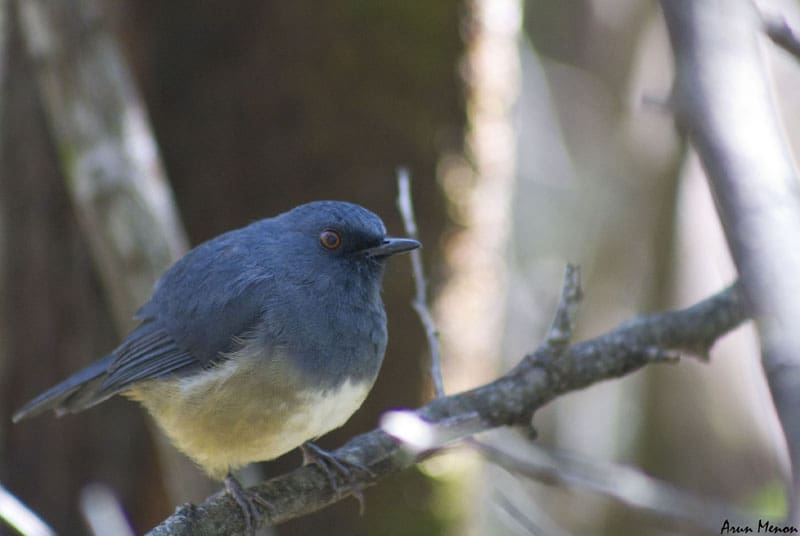When you see eye to eye with a bird for the first time and don’t know what to call it, just watch. Taxonomy be damned!
Last year, I had been to the fishing hut at Mukurthi with a group of friends. Mukurthi is a small National Park created to protect the Nilgiri Tahr and is a part of the Nilgiri Biosphere Reserve. The majority of the park, although full of grasslands interspersed with numerous and isolated sholas, has large areas covered with pine and wattle, which were introduced here during the beginning of the last century. Hence, areas with stable ecosystems have been lost to monoculture which supports less biodiversity. Yet, life still thrives.
Although my heart sank at the sight of the vast tracts covered in almost inaccessible wattle, a couple of things did bring my spirits back up. One was the sight of extensive grasslands that stretched far and wide. The other was the sight and subsequent observation of a particular bird. A bird, which I realized later, I had wrongly ID-ed. On the second day after our arrival, while looking for birds around the fishing hut, I saw a small blue bird move deep in the wattle undergrowth. It was blue — not bright blue, but duller. That’s all. No other clue. I hoped I might see it again and I did, the next morning, just before leaving.
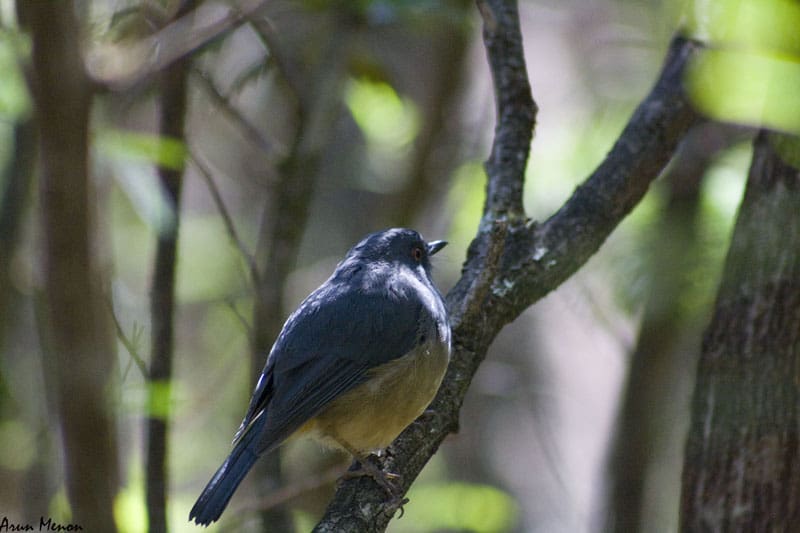
We had to leave by around 10 in the morning, so I set out to do my final round of birding by around 7:30. And this time, I birded alone (sometimes I enjoy it better than being in a group; I concentrate more). After spotting warblers and great tits, I moved further up the path where the wattle grew denser. Here, you could barely see the sky clearly because of the wattle covering your view. So, as my focus was mostly fixed on the lower sides of the path, my eyes spied a movement. I looked, and saw blue. The same blue that I had seen the previous day. The bird was in the undergrowth quite close to the path. But the light did not help much. It flew and I followed, like a cat watching its quarry. This hide-and-seek continued for over 15 minutes with the bird completely disappearing at one point, only to reappear a couple of minutes later. By now I had started deciphering its appearance. It was dull blue on the upperparts with a bright red eye. After reappearing, the bird slowly started moving closer to the path where I was, as if it wanted to size me up. Once it came to the edge of the clearing, it perched on a twig about 6 to 7 feet away and regarded me with utmost curiosity. I think this was the moment the bird and I realized we could be comfortable in each other’s company. After this ice-breaker of a stare, the bird started moving about on the ground, near me, foraging.
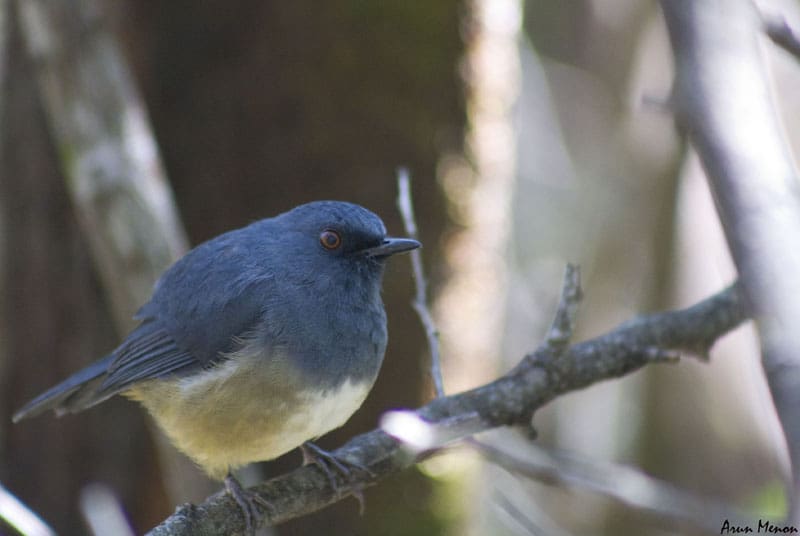
After a couple of years of birding, most people can understand the tolerance levels of birds with relation to the proximity of humans. I instinctively knew after the stare that I could now get quite close to this bird without spooking it. So I went closer and sat down within 6 feet of it. It stopped to regard me and, once I sat down, continued foraging. After that the bird and I spent about 20-25 minutes in each others company. This was one of the best experiences I have had, birding. I was not bothered about which species it was, or if it was a lifer. I just sat motionless and watched till my legs grew numb. As it intently foraged, I intently observed it and took a couple of shots. The light was extremely dull and the frames I got were not of great quality as I was working with my modest but trusty equipment. In addition to the blue upperparts, the bird had a blue throat and breast. The belly was white with a rufous wash in the flanks going all the way down to the vent. Even the bill seemed to be of the same shade of blue. At this point of time I did not know the identity of the bird but based on its build and behaviour I assumed it was one of the several species of blue coloured flycatchers found in the Western Ghats.
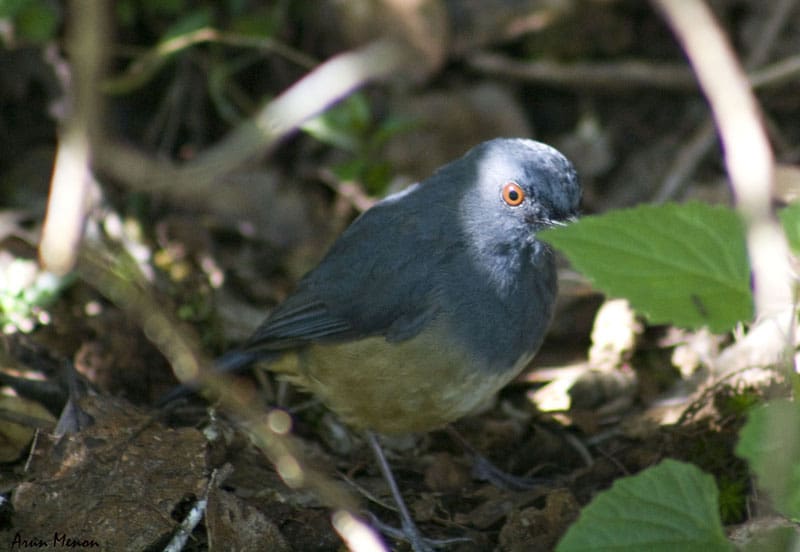
Realizing that it was getting late, I left the bird’s company with regret and went back to the fishing hut. At the camp, I showed a fellow birder a photo I had taken, for identification. He looked at it and told me that it was a White-Bellied Blue Flycatcher. Although I did take a look at the field guide after coming back from the trip, I guess I did not bother to check it properly. A few days later, after the trip, the same friend asked me to check if the bird that I showed him was the rufous race of the White-Bellied Shortwing (Brachypteryx major). This I did and it turned out to be the shortwing, a highly endangered bird endemic to the Western Ghats.
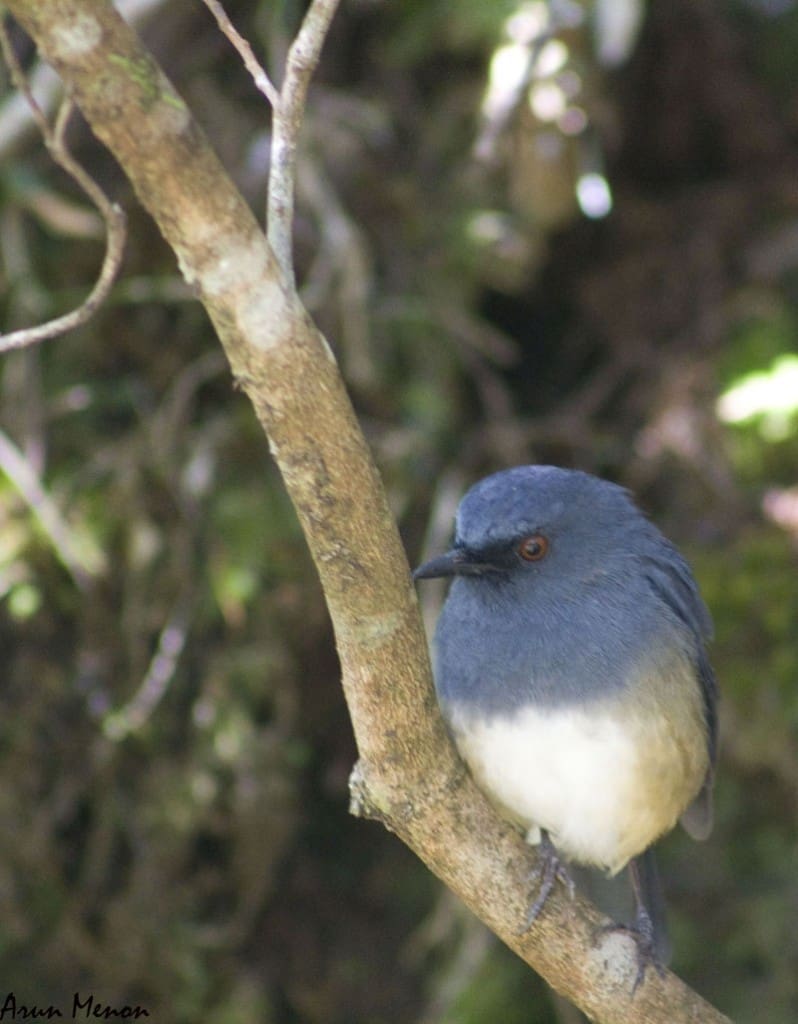
Previously published literature considers two separate races within the species based on differences in the colour of the plumage — the nominate race Brachypteryx major major and Brachypteryx major albiventris. There had been some debate whether these are in fact two races — or two totally different species. In their research, A view from the past: Shortwings and sky islands of the Western Ghats, V V Robin, Anindya Sinha and Uma Ramakrishnan suggest, following Salim Ali’s and Dillon Ripley’s study, that the two races be considered as separate species as there was a split in the initial population around five million years ago, followed by the isolation and consequent evolution of these populations as distinct species. In the study, they emphasize on “sky islands” being the reason for this isolation. Sky islands are high-elevation regions where certain life forms are restricted. For animals that never come down to the lower elevations, it is as if they are living on islands. These islands are made up of a sequence of valleys and mountains. They claim that the trigger for the occupation of these high-elevation regions and isolation was the glacial maxima, popularly known as the Ice Age. As the wet forests retreated to the higher elevations during the last Ice Age, the birds followed and evolved specifically suited to such habitats. And, instead of entire populations of shortwings being together in one place, independent populations formed on different mountain tops.
And thus, based on their research, the authors propose that the northern species (the population found north of the Palghat Gap) be called the Rufous-Bellied Shortwing (Brachypteryx major) and the southern species (the population found south of the Palghat Gap) be called the White-Bellied Shortwing (Brachypteryx albiventris). So what does this species split mean from the point of view of conservation? Earlier, when they were just considered as races, the conservation status was considered for the entire population. But now this has to be re-examined as the northern species has a much smaller range.
Now for the few of us, who, like me, are not in great touch with the recent changes in the naming conventions in the birding world, here’s news: These two species have been recently removed from the genus Brachypteryx and are placed under the genus Myiomela. And their common names have been changed to from Rufous-Bellied Shortwing and White-Bellied Shortwing to Nilgiri Blue Robin and White-Bellied Blue Robin respectively.
And I thought it was just another blue bird in an overgrown wattle grove!
Text and photos: Arun
- Savannah Sprinter – A day at the office with the cheetah - April 9, 2020
- Mangalajodi – birds and serenity in a winter wetland - April 14, 2018
- Let the sleeping tiger lie – on meeting the big cat on foot - March 13, 2017

